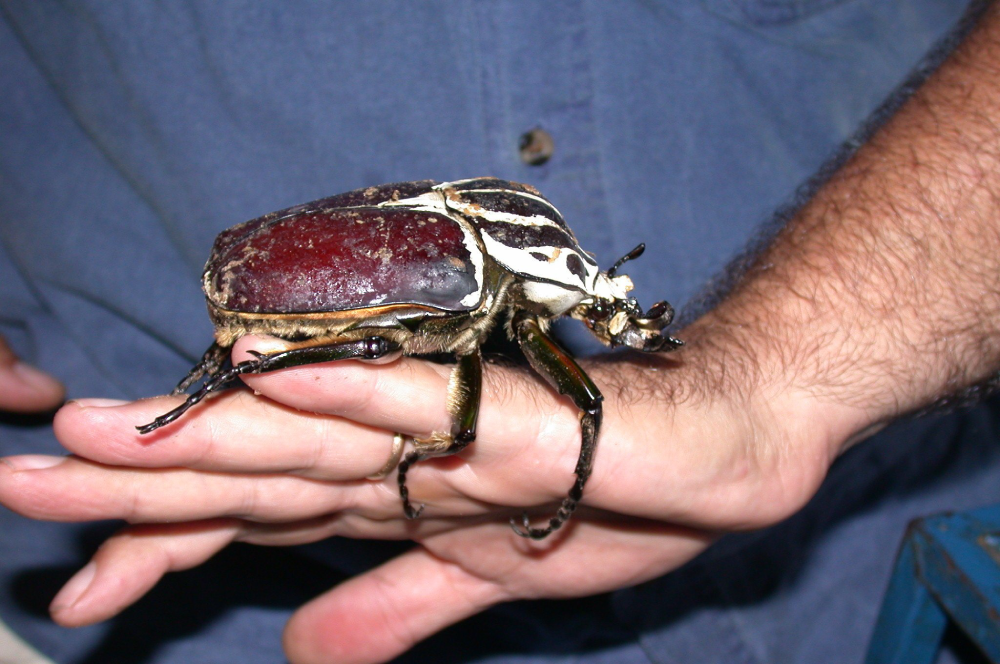Introduction to the Goliath Beetle
The Goliath beetle (scientifically known as Goliathus spp.) belongs to the family Scarabaeidae, which includes some of the largest beetles on the planet. These magnificent creatures are native to the tropical forests of Africa, where they inhabit the dense foliage and forest floors of countries such as Tanzania, Uganda, and the Democratic Republic of the Congo. Within these lush habitats, Goliath beetles play a vital role in ecosystem dynamics, contributing to nutrient cycling and decomposition processes.
Physical Characteristics
One of the most striking features of the Goliath beetle is its imposing size. Among the largest insects in the world, adult Goliath beetles can measure up to 4.3 inches (11 centimeters) in length, with some species reaching even greater lengths. Their impressive bulk and robust build make them a formidable presence in their environment, dwarfing many of their insect counterparts.
In addition to their size, Goliath beetles are renowned for their striking coloration and elaborate patterns. Their exoskeletons boast vibrant hues of black, brown, white, and green, often adorned with intricate markings and designs. These colors serve both functional and aesthetic purposes, helping to camouflage the beetles amidst the foliage while also serving as signals to potential mates.

Life Cycle and Behavior
The life cycle of the Goliath beetle is a fascinating journey marked by distinct stages of development. Like all beetles, Goliaths undergo complete metamorphosis, progressing through egg, larval, pupal, and adult stages. The journey begins when a female beetle lays her eggs in decaying organic matter, providing a rich source of nutrients for the developing larvae.
Goliath beetle larvae, often referred to as grubs, are voracious feeders, consuming large quantities of rotting wood and plant material. This diet not only sustains their growth but also plays a crucial role in breaking down organic matter and recycling nutrients within the ecosystem. Over several months to years, depending on environmental conditions, the larvae undergo multiple molts as they grow larger and more robust.
Once fully grown, the larvae undergo a remarkable transformation, forming a protective cocoon around themselves as they enter the pupal stage. Within this cocoon, profound changes occur as the larvae undergo metamorphosis, reshaping their bodies into the recognizable form of adult beetles. After a period of development, the mature beetles emerge from their cocoons, ready to embark on their brief but impactful adult lives.
As adults, Goliath beetles focus primarily on reproduction, utilizing their keen senses to locate potential mates. Males are known for their impressive horns, which they use to compete with rival males for access to females and territory. These contests can be intense, with males engaging in pushing matches and jousting bouts to establish dominance. Once a successful pair forms, the female lays her eggs in a suitable substrate, thus continuing the cycle of life for future generations.
Ecological Importance
Beyond their aesthetic appeal and fascinating behaviors, Goliath beetles play a vital role in the ecosystems they inhabit. As larvae, they contribute to the decomposition of organic matter, aiding in the recycling of nutrients and the enrichment of soil. Their feeding habits help to break down dead wood and plant material, facilitating nutrient cycling and contributing to the overall health of forest ecosystems.
Furthermore, Goliath beetles serve as important prey items for various predators, including birds, reptiles, and mammals. Their large size and relatively slow movements make them vulnerable to predation, but they have evolved several strategies to evade capture, including camouflage and rapid flight when threatened. By serving as a food source for other organisms, Goliath beetles help to maintain the balance of predator-prey relationships within their ecosystems.
Conservation Status and Threats
Despite their impressive adaptations and ecological significance, Goliath beetles face numerous threats to their survival, primarily due to habitat loss and degradation. Deforestation, agricultural expansion, and urbanization have all contributed to the decline of their native habitats, reducing the availability of suitable breeding and feeding grounds.
Additionally, the illegal pet trade poses a significant threat to Goliath beetle populations, as they are often sought after by collectors for their size and beauty. Over-collection can have devastating effects on local populations, leading to declines in abundance and genetic diversity.
To address these threats and conserve Goliath beetle populations, efforts are underway to protect their natural habitats, promote sustainable land management practices, and raise awareness about the importance of insect conservation. By safeguarding the ecosystems upon which Goliath beetles depend, we can ensure the continued survival of these remarkable creatures for generations to come.
Conclusion
In conclusion, the Goliath beetle stands as a remarkable example of the wonders of the natural world. From its impressive size and striking appearance to its vital ecological role, this magnificent insect captivates the imagination and inspires awe and admiration in all who encounter it. By understanding and appreciating the importance of Goliath beetles and their habitats, we can work together to ensure their continued survival and contribute to the preservation of biodiversity on our planet.









